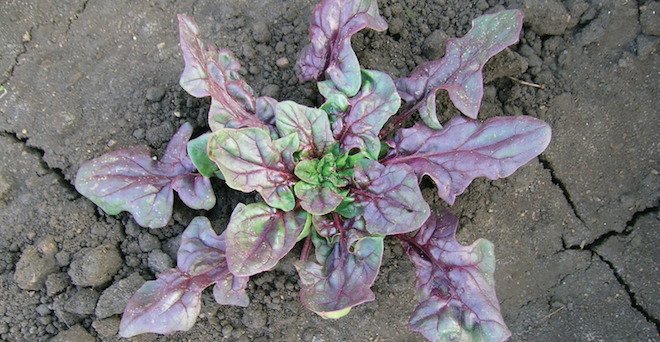

Feb 12, 2020USDA debuts world-first true red spinach
Spinach leaves of a rosy hue stand to shake up salad mixes in produce aisles everywhere.
The USDA Agricultural Research Service (ARS) in December debuted “the world’s first true red spinach variety.” The variety, called USDA Red, will likely be commercialized by a seed company through ARS’ Office of Technology Transfer.
USDA hopes the new diversity could help spinach sales, which have lagged since a 2006 outbreak of E. coli-caused illnesses were linked to California-grown spinach. More than 204 people were sickened and three died during the outbreak. U.S. Food and Drug Administration advised against eating bag spinach, and there were no U.S. fresh spinach sales for five days.
Since the outbreak, Spinach consumption in the U.S. has dropped to 1.6 pounds per person, down from 2.3 pounds per person before the outbreak in 2006, and has never recovered from the change.
Breeder Beiquan Mou said he hopes the new variety could revive the spinach market.
“I got just a tremendous response from the growers,” he said. “I think the demand, interest, is there. We are talking to several seed companies.”
Although commercial companies may be interested in licensing the seed to create hybrid varieties, USDA Red also can stand on its own, said Mou, an ARS research geneticist Crop Improvement and Protection Research Unit in Salinas, California.
“It’s not germplasm of a breeding line – it’s a finished variety,” he said.
USDA Red can be harvested as a baby leaf or “teen” leaf in three or four weeks, and grown to maturity over two months for frozen or canned products. The leaves grow semi-flat, with “spade-shaped” leaves with “round-pointed tips,” according to the USDA’s announcement. The plant has moderate resistance to bolting.
The red leaves in many mixes are currently provided by red lettuce, radicchio or chard, but a true-red spinach leaf will give consumers a new and perhaps more-desirable leaf to throw in the mix. Spinach is, after all, prized for its nutritional value, including beta-carotene (provitamin A), lutein, folate, vitamin C, calcium, iron, phosphorus and potassium.
“Not only does it look good, it has health benefits,” Mou said.
Mou said the red color doesn’t affect the leaves’ nutritional content, and on top of that, USDA Red tastes great (He joked that it should be called Red Delicious).
Other produce varieties have been marketed as red spinaches, but the USDA said these are actually red-leaf amaranths or other plants like Red Goosefoot (Blitum rubrum). Some true spinach plants have a bit of red, but only along the leaf veins – and it’s with one of those varieties, namely Bordeaux, that Mou started his breeding work.
He conducted his natural, non-GMO breeding process in about 100 small (5’x5’) isolated greenhouses. Raised in a controlled environment, the plants were ventilated, and were lighted to simulate the long days that trigger flowering. Plants a little redder than the rest were selected for crosses.
“It took us ten years,” Mou said. “Little by little, the red accumulated.”
The red itself comes from the betacyanin, an antioxidant. According to the USDA’s announcement, betacyanin has been shown in scientific literature to reduce oxidative stress in patients and might help in preventing inflammation and chronic medical conditions. The antioxidant capacity of USDA Red was 42%-53% more than other spinach cultivars in five tests conducted over three years.
Mou said growers have told him they’re eager to try planting it.
“Hopefully, we can bring it to the market as soon as possible,” he said. “This is really just a breakthrough, but we don’t really have enough seeds for them right now.”
— Stephen Kloosterman, associate editor














